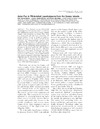Identificador persistente para citar o vincular este elemento:
https://accedacris.ulpgc.es/handle/10553/73679
| Campo DC | Valor | idioma |
|---|---|---|
| dc.contributor.author | Medina, FM | en_US |
| dc.contributor.author | Ramírez, Gustavo | en_US |
| dc.contributor.author | Hernández, Antonio | en_US |
| dc.date.accessioned | 2020-07-15T10:03:13Z | - |
| dc.date.available | 2020-07-15T10:03:13Z | - |
| dc.date.issued | 2004 | en_US |
| dc.identifier.issn | 0090-3558 | en_US |
| dc.identifier.other | WoS | - |
| dc.identifier.uri | https://accedacris.ulpgc.es/handle/10553/73679 | - |
| dc.description.abstract | Two diseased young white-tailed laurel-pigeons (Columba junoniae), an endemic and endangered species of the Canary Islands (Spain), were found in La Palma. They were very depressed and had severe cutaneous yellowish nodular lesions in feathered and unfeathered areas on the bodies of both birds. Necropsy and histopathologic analyses were conducted. The presence of epidermal hypertrophy and hyperplasia in cutaneous lesions, as well as several acidophilic intracytoplasmic inclusions in affected epithelial cells (Bollinger bodies), confirmed avian poxvirus infection. This is the first report of avian pox in white-tailed laurel-pigeons or in any other free-ranging bird in the Canaries, and it might indicate that other threatened birds of the Canarian Archipelago may be affected by this viral disease. | en_US |
| dc.language | eng | en_US |
| dc.relation.ispartof | Journal of Wildlife Diseases | en_US |
| dc.source | Journal Of Wildlife Diseases [ISSN 0090-3558], v. 40 (2), p. 351-355, (Abril 2004) | en_US |
| dc.subject | 310907 Patología | en_US |
| dc.subject.other | Avian Pox | en_US |
| dc.subject.other | Canary Islands | en_US |
| dc.subject.other | Columba Junoniae | en_US |
| dc.subject.other | Endemic Bird | en_US |
| dc.subject.other | La Palma | en_US |
| dc.subject.other | Pox-Virus | en_US |
| dc.subject.other | White-Tailed Laurel-Pigeon | en_US |
| dc.title | Avian pox in white-tailed laurel-pigeons from the Canary Islands | en_US |
| dc.type | info:eu-repo/semantics/Article | en_US |
| dc.type | Article | en_US |
| dc.identifier.doi | 10.7589/0090-3558-40.2.351 | en_US |
| dc.identifier.scopus | 4043053891 | - |
| dc.identifier.isi | 000222553000027 | - |
| dc.contributor.authorscopusid | 7101954537 | - |
| dc.contributor.authorscopusid | 25623593400 | - |
| dc.contributor.authorscopusid | 55437102100 | - |
| dc.description.lastpage | 355 | en_US |
| dc.identifier.issue | 2 | - |
| dc.description.firstpage | 351 | en_US |
| dc.relation.volume | 40 | en_US |
| dc.investigacion | Ciencias de la Salud | en_US |
| dc.type2 | Artículo | en_US |
| dc.contributor.daisngid | 1543748 | - |
| dc.contributor.daisngid | 389144 | - |
| dc.contributor.daisngid | 14941824 | - |
| dc.description.numberofpages | 5 | en_US |
| dc.utils.revision | Sí | en_US |
| dc.contributor.wosstandard | WOS:Medina, FM | - |
| dc.contributor.wosstandard | WOS:Ramirez, GA | - |
| dc.contributor.wosstandard | WOS:Hernandez, A | - |
| dc.date.coverdate | Enero 2004 | en_US |
| dc.identifier.ulpgc | Sí | en_US |
| dc.contributor.buulpgc | BU-VET | en_US |
| dc.description.jcr | 0,741 | |
| dc.description.jcrq | Q2 | |
| dc.description.scie | SCIE | |
| item.grantfulltext | open | - |
| item.fulltext | Con texto completo | - |
| Colección: | Artículos | |
Citas SCOPUSTM
21
actualizado el 08-jun-2025
Citas de WEB OF SCIENCETM
Citations
18
actualizado el 08-jun-2025
Visitas
157
actualizado el 04-ene-2025
Descargas
123
actualizado el 04-ene-2025
Google ScholarTM
Verifica
Altmetric
Comparte
Exporta metadatos
Los elementos en ULPGC accedaCRIS están protegidos por derechos de autor con todos los derechos reservados, a menos que se indique lo contrario.
